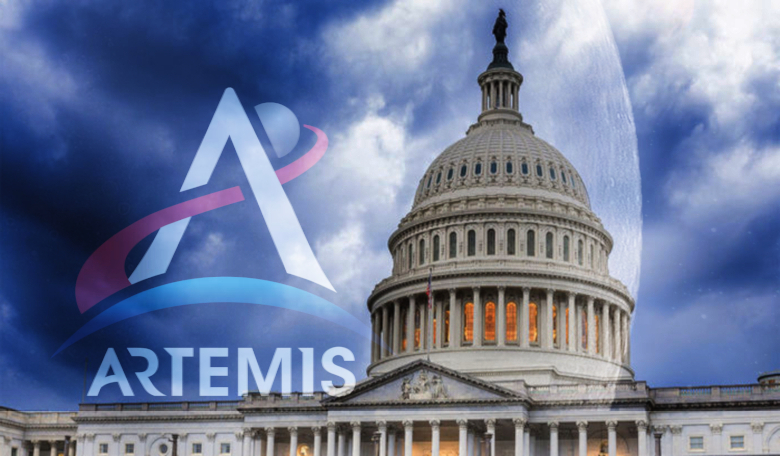In an effort to end the spending deadlock between US Democrats and Republicans in Congress, the House and Senate Appropriations Committees yesterday passed a number of bills increasing funding for a number of US agencies in FY 2020, one of which will see NASA receive $22.629 billion as part of the Science appropriation bill.
However the prospect of putting astronauts on the Moon by 2024 received another blow as the bill only partially funds the $1.6 billion supplemental request for the Artemis program and key officials were equally dismissive in being able to adhere to Trump’s ambitious deadline;
“Some experts have said that additional financial resources needed to meet the Administration-imposed 2024 deadline could exceed $25 billion over the next five years, compared to the original 2028 schedule. To date, NASA has not provided the Committee with a full cost estimate, despite repeated requests,” said Congressman José E. Serrano (D-NY), Chair of the Commerce, Justice, Science and Related Agencies Appropriations Subcommittee, as he spoke on 16 October, 2019 at the Subcommittee's hearing on NASA's proposal to advance the next moon landing by four years.
“Overall, I remain extremely concerned by the proposed advancement by four years of this mission. The eyes of the world are upon us. We cannot afford to fail. Therefore, I believe that it is better to use the original NASA schedule of 2028 in order to have a successful, safe, and cost-effective mission for the benefit of the American people and the world,” said the long-term supporter of NASA.
The Senate had passed a spending bill back in October that provided $22.75 billion for NASA in fiscal year 2020, but a final agreement on funding for the agency’s programmes was not finalised.
An additional $1.6 billion supplemental for Artemis was requested by the administration in a budget amendment back in May, which included $1.045 billion for human lunar landers, but the final 2020 spending bill passed yesterday provides only $600 million – less than half what was requested.
Furthermore, the bill requires that NASA submits a multi-year plan explaining how it intends to execute that program including key milestones and funding estimates in order for Artemis-related funding to be released.
Of the $22.629 billion awarded to the Commerce-Justice-Science (CJS) bill that funds NASA, Science is set to receive $7,138.9 million, Aeronautics: $783.9 million, Space Technology: $1,100 million, Exploration: $6,017.6 million and Space Operations: $4,140.2 million.
The Exploration portion of the budget (which includes most of the Artemis program) will see the agency’s Space Launch System (SLS), receive $2,585.9 million, of which $300 million is for the Exploration Upper Stage (EUS); Orion gets $1,406.7 million; Exploration Research and Development receives $1,435 million, of which $450 million is for Gateway, $600 million is for Advanced Cislunar and Surface Activities (the human lunar landers), $140 million for the Human Research Program, and $245 million for Advanced Exploration Systems and finally Exploration Ground Systems, $590 million.
The Planetary Science budget secured $2,713.4 million. Of this, $300 million is set aside for the Lunar Discovery and Exploration Program (LDEP), which funds robotic lunar landers and the Lunar Reconnaissance Orbiter (LEO); $502.7 million is for New Frontiers missions and $190.4 million is for Discovery missions.
NASA’s successor to Hubble, the James Webb Space Telescope, was also allocated $423 million and funding was also provided for a new space-based telescope that will help boost ground-based observations in detecting and tracking asteroids.
Another notable project to secure a continuation of funds for the next year was the Europa Clipper. The bill specifies that NASA must also develop a Europa Lander – a separately launched spacecraft that would lay a foundation for the Europa Lander mission and that both spacecraft should be launched on the SLS. Factoring in the potential for delays, dates for launching the craft were extended by two years each; 2025 and 2027 for the Clipper and Lander respectively
The bill also rejects the Trump Administration’s proposals to terminate or postpone a number of key programmes including two Earth science initiatives, PACE and CLARREO-Pathfinder, and the Wide-Field Infrared Survey Telescope (WFIRST). WFIRST was recommended in 2010 by United States National Research Council Decadal Survey committee as the top priority for the next decade of astronomy, but development did not begin until February, 2016.
To help NASA continue game changing technology for deep space exploration, $110 million was set aside for Nuclear Thermal Propulsion as part of the Space Technology budget, with $60 million allocated for a flight demonstration by 2024.
The Space budget, which will receive $1.1 billion over all, also sees funds to the tune of $227.2 million go to the RESTORE-L program. RESTORE-L is a robotic spacecraft equipped with the tools and technologies needed to extend satellites' lifespans. This programme budget includes monies for the completion of SPIDER, a SPace Infrastructure DExterous Robot (SPIDER) that the robotic satellite servicing platform will carry as a secondary payload.
The remaining CJS bill funding of $3,448.4 million is split between Safety, Security and Mission Services, Construction and Environmental Compliance and Restoration, Office of Inspector General and STEM Engagement.
The Trump Administration had already proposed to terminate NASA’s education programs, however, this was once again rejected by Congress.
Last but not least, under the Defence Appropriations bill, $40 million was allocated – $72.4 million was requested – for the establishment of the US’s new Space Force. This soon-to-be sixth military service can now be created after Senate passed the final version of the FY2020 National Defense Authorization Act (NDAA) yesterday. Now that the last legislative hurdle has been passed, all that remains is for President Trump to sign the bill into law.











